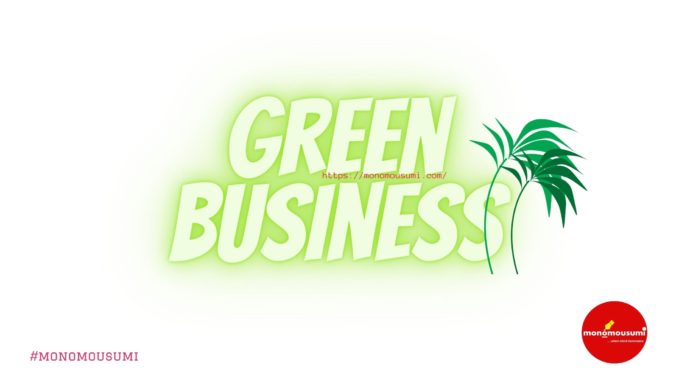We are living in a rapidly evolving era of science and technology. However some man-made disasters and natural calamities have left an irreversible damage on the environment so we should be cognizant of protecting our mother Earth to sustain the available natural resources for future generations. Due to the unexpected outbreak of COVID-19 pandemic, strict rules and regulations like lockdown, quarantine and social distancing have been imposed worldwide to curb the adverse effects of the virus, but its negative impact on the economy and mental health is still prevalent. As a consequence, green business has become increasingly significant globally with respect to the current scenario. Moreover, green advertising is regarded as an effective method for the promotion of eco-friendly products, services and business ideas, since it is deeply linked with the conservation of the natural environment. In the 1980s, the impact of green marketing spread like a wildfire and has been a major interest for many scholars and businessmen. Green business witnessed rapid growth in the United States, and constitutes a market worth USD 250 billion annually in the United States alone.
The four P’s of Green Marketing
(Source : Pinterest) The Four P’s of Green Marketing
Business plays a pivotal role in withstanding major challenges and strengthening the economy of the world. Nowadays one cannot flourish in any business without proper marketing strategies. When it comes to sustainable green marketing the four “P’s” are of utmost importance :-
Product
In this phase, the producer should manufacture and offer ecological products which must not contaminate the environment. Furthermore raw materials, ingredients, fair trade suppliers and machinery should be taken into consideration to minimize the company’s carbon footprint. Finally it should protect and even liquidate the existing environmental damages. For instance, Unilever company (the corporate owner of Ben and Jerry’s) has claimed that the ingredients used in their ice cream are sourced through fair trade ( global trade system that ensures producers get a genuine rate for their goods) suppliers and is officially certified.
Price
Price is usually the monetary amount paid by a consumer for a product or service depending on its value or worth. For sustainable goods, price is often a major issue thereby limiting its production and distribution rate. Eco friendly products are often deemed to be more expensive than their conventional counterparts. For example, organic food grown using natural fertilizers are more expensive than food that uses chemical fertilizers. Thus marketers must find some ways to slightly minimize the cost, closer to its conventional counterparts or achieve the desired rate through means of marketing. Some popular organic food brands like Earth’s Best Organics, Whole Food Markets, Amy’s Kitchen, Mary’s Gone Crackers, Farm2Kitchen, My Green Kart, Organic Harvest etc are successful in creating greater perceived value, thus commanding premium pricing.
Place
In this phase, distribution logistics is of crucial importance. It primarily focuses on how the products can be purchased and how it can be supplied or distributed to the purchase location. The place can be ‘physical’ or ‘virtual’. For instance world famous e-commerce, Amazon sells eco friendly products, whereas Myntra, Flipkart, Ajio etc provides green clothing which uses organic synthetic fibres and colours for apparels. According to NBC reports, Popular multinational retail stores like Kohl’s and Walmart are implementing solar energy panels in some of their stores thereby building more energy-efficient stores. In addition alternative fuels are used in its trucks to reduce packaging expenditure.
Promotion
This phase highlights the communication tools and tactics that a company adopts to promote and market their products. Usually there are various constructive ways to communicate a company’s products and benefits. Hence in communications platform, ‘Branding’ is very prominent, because it is like an indelible image that is imprinted in the mind’s of potential customers. Nowadays there are many social platforms for promotion of products such as, TV Advertising, Digital Marketing, Social Media (Instagram, Facebook, YouTube) etc. Popular sports brand, Nike recently made headlines with its marketing ability of creating a better world through sports. Their efforts included the first 100 % recycled television advertising that reused and remixed films from their previous campaigns over the years to create a new spot to introduce their Better World campaign. Colorado (U.S.A) based, the Denver Water Company’s advertising campaign in 2016 visually highlighted their eco-friendly tagline of “Use Only What You Need” which inculcated the importance of water conservation.
Some effective ways of doing Green Marketing.
(Source : Knoema) Green Economy ranking of top 5 world’s largest economies.
The term, ‘Green Marketing’ is referred to as marketing of environmentally safe products. Over the past few decades, the demand for organic food and farming has been increasing in various parts of the world. According to the research by Organic Trade Association (OTA), organic food sales have witnessed 20% growth per annum since 1990, while traditional foods markets have grown 33%. The reports are quite indicative of the statement “The market is turning green, not adding green”. Some effective methods of doing, ‘Green Marketing’ are as follows:-
1) Green Design
One of the most crucial and initial green marketing strategies is to design green products and services. This involves implementation of green strategies during the early stages of planning and designing of products, so they become more eco-friendly. According to award winning British architectural design and engineering firm, Foster and Partners – “Green Designing refers to the creation of products that are energy-efficient, flexible, comfortable to use, and designed for a long life or to reuse whenever required”.
2) Green Positioning
This method tends to establish brand associations by delivering quality services and information on environmentally sound product attributes. The commercial success of eco-friendly products depends on effective communication of green branding attributes. For instance, the Body Shop expects it’s customers to consider that their products have natural, ethical and environmental story.
3) Green Pricing
In Green Pricing, the market can reap the benefits procured by selling green goods and services to the customers who contributed in saving energy and preserving the environment, thus strengthening the economy of nation. Furthermore it also allows consumers to participate in sustainability, so that they can invest in something that will allow them to save money and resources in the future. For instance, popular detergent brands like Surf Excel, Ariel and Tide produces concentrated formula that can help in saving upto 50% on electricity bill and eliminates the need to wash clothes in warm water. So by buying such kind of detergents, consumers can indirectly reduce energy consumption and contribute to sustainability.
4) Green Packaging
In this method, companies make use of eco-friendly materials made up of organic compounds. Such kind of packaging has a low impact on both energy consumption and environment and also attracts many eco-conscious customers. For instance, Dell brand first introduced bamboo packaging in 2008. Later in 2010, it started shipping bigger products in packaging made from recyclable and compostable fungus material, combined with commercial agricultural waste.
5.) Green Disposal
This final method takes into consideration each and every aspect of a product’s life cycle – starting from production to disposal. It restrains use of non decomposable materials like batteries, medical waste, polystyrene, plastic, paint, tyres, thermo coal, carbon paper and other toxic chemicals. This method has already influenced many recycling and waste management programs. For example by 2030, the Coca-Cola company is planning to manufacture all plastic bottles from 50% recycled plastics. In 2019, it unveiled the first look of sample bottle made using waste marine plastics.
Understanding the term ‘LOHAS’
(Source : Mint) LOHAS stands for Lifestyles of Health and Sustainability.
‘LOHAS’ is an acronym for Lifestyles of Health and Sustainability, which is a demographic, (statistical study of human population) that describes rapidly growing market for goods and services and captivates consumer’s sense of environmental and social responsibility thereby influencing their purchase decisions. According to reports by Worldwatch Institute, in 2006 the market segment was estimated at $300 billion. Consumers under LOHAS category, prefer to purchase eco-friendly products even though they are very expensive. For instance 26% of LOHAS consumers are willing to pay upto 20% more for ecofriendly products. Such type of consumers tend to influence other customers. But the biggest challenge is creative cross promotion and segment collaboration with environment consicous and socially responsible companies which in turn provides more consumer choices. According to reports, about 98% of LOHAS consumers are aware of green (organic) products but only 37% have purchased or used it. This clearly shows that more consumer education is required and also the price disparity between organic and conventional food needs to be balanced.
What is “GREEN WASHING ?”
(Source : 100 Days of Real Food) Greenwashing is a major challenge in green marketing.
The issue of ‘Greenwashing’ is a major concern since 1960. It is the practice of misleading the customers by conveying false impression and doing deceitful marketing about how a company’s products are more environmentally sound. In simple words such products and services hardly has any benefits for environment. The popular Nestle brand was accused of greenwashing after announcing sustainably sourced cocoa beans despite swathes of related deforestation in West Africa. In Canada and United States approximately 2,219 products were making 4,996 green claims, out of which over 98% committed at least one of the following that TerraChoice Environmental Marketing referred to as “The Seven Sins of Greenwashing.”
1.) Hidden Trade-Off
It revolves around classifying a green product based on provided narrow set of information or attributes. For instance, a product made of recycled materials may appear sustainable but during the manufacturing process it may consume high energy or even pollute the environment by using toxic chemicals.
2.) No Proof
One of the principle greenwashing tactics is luring the customers to use green products without providing valid reason or proof. For example, some companies claim they manufacture and sell green products but actually, they don’t provide real information about the raw materials, supply chain, or manufacturing process used.
3.) Vagueness
It usually refers to a claim that is poorly defined or explained having no meaning and is made with the intention to mislead the consumers. For example, “all natural” products or services doesn’t have any sense because chemicals like arsenic, uranium, mercury, and formaldehyde are all naturally occurring and poisonous. Thus all natural isn’t necessarily green.
4.) Worshipping False Labels
In this a company showcases eco-friendliness with an enticing label that, at first glance, appears to have third party endorsement by a bonified environmental company. But in reality no such certification exists. For instance some products falsely claim to be Energy Star certified or registered.
5.) Irrelevance
This generally refers to an environmental claim that may be truthful but is unhelpful or useless for consumers, since it distracts them. CFC (chlorofluorocarbons) free is a common example of irrelevancy since a law was passed in 1978 to not use CFC (ozone depleting chemicals) in products.
6.) Lesser of two evils
In lesser of two evils sin, the claim may be technically true within the product category but consumers are distracted from the health risks and environmental impacts. Some common examples include organic cigarettes, vitamin infused vodka or fuel-efficient sport-utility vehicles .
7) Fibbing
This sin is committed by making environmental claims that are untrue, thereby misleading the customers. For example, ExxonMobil an American multinational company claimed, they were reducing greenhouse gas emissions but they were actually increasing it.
In such situations, one of the best way to protect ourself from getting “greenwashed” by some organizations or companies is by educating ourselves on the important environmental issues when it comes to purchasing products. We should even familiarize ourselves with the most genuine and trust-worthy eco certification labels, that will assist us in identifying whether the products are truly ecofriendly or not!
Going green is becoming a profitable business strategy worldwide based on the environmental scenario today. Hence sustainable values has superseded a focus on product, lifestyle, and many other previous marketing methods. Consumers buy green products for a reason, so companies need to understand what motivates the consumers so they can align their operations and communications to emphasize these values. Real success comes not just from using a green message, but by applying all of the wisdom from the marketing discipline.
By Richie Elangical
















